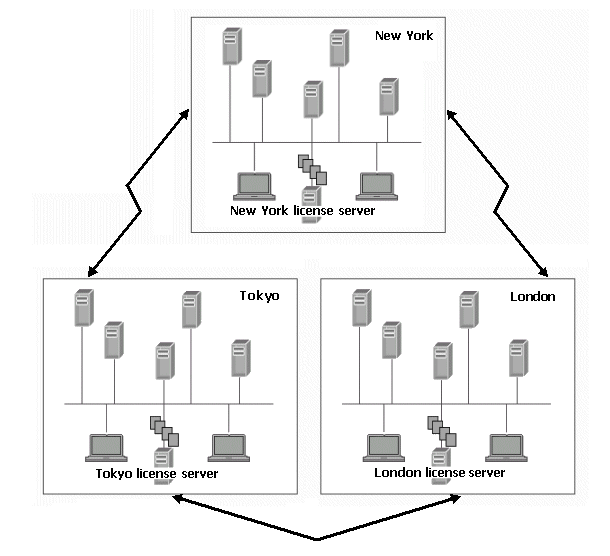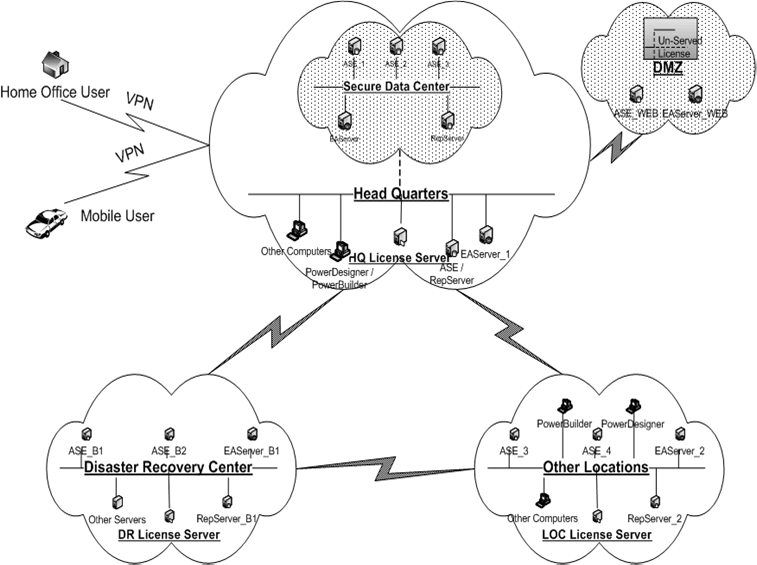This deployment scenario has multiple sites, each with multiple Sybase products, with a license server at each site. This removes the dependency on network availability and latency, and can provide load balancing.
The "Multiple Sites and License Servers" figure illustrates an organization with major sites in New York, London, and Tokyo. Each site uses multiple instances of multiple Sybase products. A license server is installed at each site and individual product instances acquire licenses from the license server at that site.
You can configure the products to find remote license servers if the required license cannot be found on the site license server, or if the site license server is not running. To share a limited number of floating licenses across all sites while using the site license server for other licenses, set up those floating licenses on the license server where floating licenses are likely to be used frequently. At the other sites, you can set up license search paths. The redundancy provided by this configuration is limited to the number of unused licenses, including any overdraft licenses that remain on each license server.
You can also consider alternate configurations: if the network communication between two sites is extremely reliable with minimal latency, you can share a license server between two sites. Smaller remote sites can share a license server with a larger site that provides the most reliable network connection, even though the larger site may not be the closest site geographically.
This setup is an extension to the multiple site case explained above. It also addresses additional considerations including security within your network, remote users, and DMZs. This setup uses a mix of license models and servers to meet your needs. Individual components of this deployment can be applied to any of the other deployment scenarios.
The "Complex, Multiple-Site Installations" figure depicts a multiple-site deployment with multiple product setup with additional security requirements. In this example:
-
The Headquarters network includes both development and production installations.
-
The production installations are set up within a secure subnet within the network.
-
The database and application servers that serve the Web are set up in the DMZ.
-
Home office and mobile users access the software remotely through VPN.
-
There is a disaster recovery center at a remote location.
-
There are other secondary sites for the organization.
This example uses a single license server for Headquarters, which serves the development, production, and remote users’ needs. While the license server is shared for development and production needs, available licenses can be demarcated based on intended deployment.
If your security policies do not permit the production subnet to access a license server outside the subnet, you must set up a separate license server inside the subnet.
SERVER server_1 ANY 27001 VENDOR SYBASE PORT=27100
Unserved licenses are set up on the DMZ to serve licenses to product instances using the Web. This reduces the need to set up another license server or open up additional traffic through the firewall.
Sybase recommends that you use a separate license server for your disaster recovery site. This ensures availability of the license server in case of a major catastrophe at the primary site.
If your disaster recovery setup includes cold-standby servers, you must set up the license servers in a three-server redundant cluster. This reduces the possibility of a license server being unavailable when a cold-standby server is attempting to come online. Such redundancy for license servers is typically not needed unless you are using cold-standby systems.
Each secondary or remote site can have its own license server.

